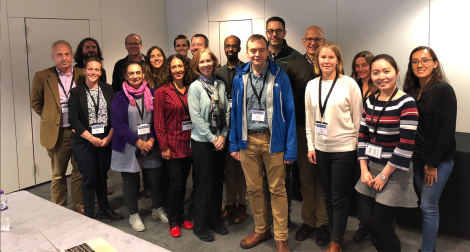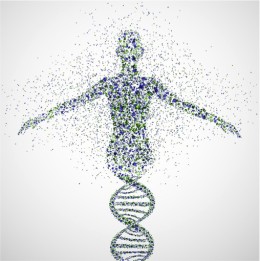by Cynthia M. Bulik, PhD
This is the first of a four-part blog series discussing the results and process of ANGI and our planned next steps in studying the genetics of eating disorders.
We are thrilled to report that the work of the Anorexia Nervosa Genetics Initiative has come to fruition! Our paper entitled, “Genome-wide Association Study Identifies Eight Risk Loci and Implicates Metabo-Psychiatric Origins for Anorexia Nervosa” was published in the journal Nature Genetics on July 15, 2019. From what we can tell, this is the first time that an empirical paper on eating disorders has been published in that august journal. Our results are intriguing and encourage us to rethink how we conceptualize anorexia nervosa.

ANGI is an initiative of The Klarman Family Foundation. Our work began in January 2013, and the four ANGI sites (University of North Carolina at Chapel Hill; Karolinska Institutet, Stockholm, Sweden; Aarhus University, Aarhus, Denmark; and Berghofer Queensland Institute for Medical Research, with assistance from the University of Otago in Christchurch, New Zealand), we collected DNA samples from 13,363 individuals who had suffered from anorexia nervosa at some point in their lives, together with control individuals who were matched on ancestry and geography. Part 2 of this blog series explains more about how global cooperation made ANGI a success!
As described in a previous post on Exchanges, ANGI was designed to be a genome-wide association study or GWAS. GWAS are discovery science—meaning that you do not have to have any prior guesses about what you are looking for on the genome, you just let the genome speak for itself. GWAS scan the entire genome for over 1 million genetic markers and compare the genomes of thousands, tens of thousands, and even hundreds of thousands of cases (in ANGI, that is people with anorexia nervosa) to the genomes of as many controls. Even though it is a massive undertaking to collect such large samples of individuals, GWAS are the preferred method for examining the genetic underpinnings of psychiatric disorders.
Now to the results. We combined all of the ANGI samples with other samples that were available as part of the Eating Disorders Working Group of the Psychiatric Genomics Consortium. Briefly, we conducted a genome-wide association study (GWAS) comparing the whole genomes of 16,992 individuals with anorexia nervosa and 55,525 controls from 17 countries across the United States, Australasia, and Europe.

Members of the PGC Eating Disorders Workgroup meeting in Glasgow
The first exciting finding was that we identified 8 regions on the genome that were significantly associated with anorexia nervosa, on chromosomes (nearest gene) 1 (PTB2), 2 (ASB3, ERLEC1), 3 (FOXP1 and NSUN3), 5 (CHD10), 10 (MGMT), and 11 (CADM1). Although exciting, this is only the beginning, as we expect hundreds of genes to be implicated in risk for anorexia nervosa. But it also shows how important sample size is for gene discovery, as our previous study with a much smaller sample, only identified one area of the genome. If we look at progress in other psychiatric disorders, we believe that we have reached an inflection point, meaning that from this point forward as we increase samples size, gene discovery will accelerate.
Perhaps the most revolutionary findings of this study are not in the gene discovery per se, but rather in the pattern of genetic correlations that we observed with other traits and disorders. Genetic correlations (meaning some of the same genes are operative) reveal associations between traits. Our results indicate that:
- The genetic basis of anorexia nervosa overlaps with other psychiatric disorders such as obsessive-compulsive disorder, depression, anxiety, and schizophrenia.
- Genetic factors associated with anorexia nervosa also influence physical activity, which could help explain the tendency for people with anorexia nervosa to be highly active.
- Intriguingly, the genetic basis of anorexia nervosa overlaps with metabolic (including glycemic), lipid (fats), and anthropometric (body measurement) traits, and the study shows that this is not due to genetic effects that influence BMI.
In fact, this pattern of correlations led us to conclude that anorexia nervosa may best be conceptualized as a ‘metabo-psychiatric disorder’ and that it will be important to consider both metabolic and psychological risk factors when exploring new avenues for treating this potentially lethal illness.
To many of us, this comes as validation of what we have suspected for decades. Many of the perplexing behaviors associated with anorexia nervosa have been explained away as either psychological phenomena or by-products of starvation. When we see someone with anorexia at very low body weight out taking a run, we assume that it is driven by the desire to lose weight. Although it may be on the psychological level, we now know that it may also have a genetic origin, as some of the same genes that influence risk for anorexia also are associated with high physical activity. Likewise, when we see someone tragically lose weight after discharge from hospital after inpatient renourishment, we typically attribute it to drive for thinness or even denial of illness. While these things may be true, we may be missing the metabolic component of the illness. Perhaps a dysregulated metabolism is why individuals with anorexia nervosa can lose so much weight in the first place, when weight loss is so difficult for the majority of the people in the world. We have speculated that starvation and weight loss feel different to people who are genetically at risk for anorexia nervosa. Whereas to most people those are deeply unpleasant experiences, for many people with anorexia, they claim that starvation and low weight are associated with being less anxious and actually feeling better physically. In fact, may patients say that they begin to feel worse when they gain weight. Perhaps a greater focus on understanding the metabolic aspects of the illness will allow us to develop more effective interventions that are acceptable to patients and have enduring effects.
We don’t know what the metabolic factors are yet, but our results strongly encourage research that addresses that question. Our results may also explain the importance of adequate renourishment when we treat anorexia nervosa. Family Based Treatment (FBT) for youth with anorexia focuses strongly on renourishment. Inpatient renourishment is often most ineffective when we are forced to discharge patients (usually due to insurance denials) before they have reached a healthy weight. Perhaps one of the reasons this happens is that we are not giving their metabolisms an opportunity to reset after prolonged dysregulation.

It is often said that good science raises more questions than it answers, but at least in this case, our results are telling us which next questions we should address. Our findings strongly encourage us to augment our current focus with more detailed explorations of metabolic factors in the hope that such a focus will improve track record among health professionals in treating this pernicious illness.
ANGI is an important beginning, but it is just a beginning. Believe it or not, our sample size is still fairly small. Our colleagues studying depression already have over 250,000 participants, and geneticists studying height and weight have over 750,000! But now we know how to do this and have a blueprint for success. Stay tuned for Part 2 of this series to describe the study in detail, Part 3 in this series for an interview with Professor Patrick Sullivan on next steps, and Part 4 for personal reflections and what ANGI results mean for patients, families, and clinicians today.
Most importantly, heartfelt thanks to every person around the world who contributed their blood and clinical information to us in order to make ANGI a success. We felt, and we hope that you felt, a sense of community around our effort to achieve our scientific goals. We could never have produced this novel understanding of anorexia nervosa without your willingness to engage with us and become part of the ANGI team. Thank you for joining us on this journey of discovery.